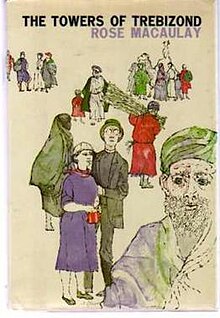
Summary
The Towers of Trebizond is a novel by Rose Macaulay (1881–1958). Published in 1956, it was the last of her novels, and the most successful. It was awarded the James Tait Black Memorial Prize for fiction in the year of its publication.
 First edition | |
| Author | Rose Macaulay |
|---|---|
| Country | United Kingdom |
| Language | English |
| Genre | Autobiographical novel |
| Publisher | Collins |
Publication date | 1956 |
| Media type | Print (hardback & paperback) |
| Preceded by | The World My Wilderness (1950) |
Plot edit
The book is partly autobiographical. It follows the adventures of a group of people – the narrator Laurie, the eccentric Dorothea ffoulkes-Corbett (otherwise Aunt Dot), her High Anglican clergyman friend Father Hugh Chantry-Pigg (who keeps his collection of sacred relics in his pockets) – travelling from Istanbul (or Constantinople as Fr. Chantry-Pigg would have it, or Byzantium as Laurie would have it) to Trebizond. A Turkish feminist doctor attracted to Anglicanism acts as a foil to the main characters.
On the way, they meet magicians, Turkish policemen and juvenile British travel-writers, and observe the BBC and Billy Graham on tour. Aunt Dot proposes to emancipate the women of Turkey by converting them to Anglicanism and popularising the bathing hat,[1] while Laurie has more worldly preoccupations. Historical references (British Christianity since the Dissolution of the Monasteries, nineteenth-century travellers to the Ottoman Empire, the First World War, the Fourth Crusade, St. Paul's third missionary journey, Troy) abound.
The geographical canvas is enlarged with the two senior characters eloping to the Soviet Union and the heroine meeting her lover in Turkey, and then her semi-estranged mother in Jerusalem. The final chapters raise multiple issues such as the souls of animals, and culminate in a fatal accident and its aftermath.
At another level the book, against its Anglo-Catholic backdrop, deals with the conflict between Laurie's attraction to Christianity and her adulterous love for a married man.[2] This was a problem Macaulay had faced in her own life, having had an affair with the married novelist and former Roman Catholic priest Gerald O'Donovan (1871–1942) from 1920 until his death.[3]
The book's opening sentence is,[4][5]
"Take my camel, dear", said my Aunt Dot, as she climbed down from this animal on her return from High Mass.
The Turkish doctor says of Aunt Dot, "She is a woman of dreams. Mad dreams, dreams of crazy, impossible things. And they aren't all of conversion to the Church, oh no. Nor all of the liberation of women, oh no. Her eyes are on far mountains, always some far peak where she will go. She looks so firm and practical, that nice face, so fair and plump and shrewd, but look in her eyes, you will sometimes catch a strange gleam."[4]
Barbara Reynolds has suggested that the character of Aunt Dot is based on Rose Macaulay's friend Dorothy L. Sayers, and that Father Hugh Chantry-Pigg has elements of Frs. Patrick McLaughlin, Gilbert Shaw and Gerard Irvine.[6]
The book was described in The New York Times: "Fantasy, farce, high comedy, lively travel material, delicious japes at many aspects of the frenzied modern world, and a succession of illuminating thoughts about love, sex, life, organized churches and religion are all tossed together with enchanting results."[2]
Editions edit
- The first UK edition was published by Collins of London in 1956.
- The first US edition (under the same title) was published by Farrar, Straus, of New York, in 1957, with a new edition by Farrar Straus & Giroux in 1980.[7]
- A de luxe edition from the Folio Society, of London, with an introduction by Joanna Trollope, appeared in 2005 and is still in print.
- A UK paperback version is also still in print, published by Flamingo.[8]
- An edition was published by The New York Review of Books in 2003 with an introduction by Jan Morris.
References edit
- Babington Smith, Constance (1972). Rose Macaulay. London: Collins. ISBN 0-00-211720-7.
- Bensen, Alice R. (1969). Rose Macaulay. New York: Twayne Publishers.
- Crawford, Alice (1995). Paradise Pursued: The Novels of Rose Macaulay. Madison, N.J.: Fairleigh Dickinson University Press. ISBN 0-8386-3573-3.
- Emery, Jane (1991). Rose Macaulay: A Writer's Life. London: J. Murray. ISBN 0-7195-4768-7.
- Fromm, Gloria G. (October 1986). "The Worldly and Unwordly Fortunes of Rose Macaulay". The New Criterion 5 (2): 38–44.
- Hein, David. "Faith and Doubt in Rose Macaulay’s The Towers of Trebizond". Anglican Theological Review 88 (2006): 47–68. Abstract: http://www.anglicantheologicalreview.org/read/article/508/
- Hein, David. "Rose Macaulay: A Voice from the Edge." In David Hein and Edward Henderson, eds., C. S. Lewis and Friends, 93–115. London: SPCK; Eugene, OR: Cascade, 2011.
- LeFanu, Sarah (2003). Rose Macaulay. London: Virago.
- Moore, Judith (15 November 1978). "Rose Macaulay: A Model for Christian Feminists". Christian Century 95 (37): 1098–1101.
- Passty, Jeanette N. (1988). Eros and Androgyny: The Legacy of Rose Macaulay. London and Toronto: Associated University Presses. ISBN 0-8386-3284-X.
Footnotes edit
- ^ Macaulay, Rose: The Towers of Trebizond (Collins, London, 1956), Chapter 2
- ^ a b The Towers of Trebizond at nybooks.com (accessed 14 November 2007)
- ^ Macaulay, Dame (Emilie) Rose (1881–1958), author by Constance Babington Smith, revised by Katherine Mullin, in Dictionary of National Biography online (accessed 15 November 2007)
- ^ a b Macaulay, Rose: The Towers of Trebizond (Collins, London, 1956)
- ^ Pearl, Nancy: Famous First Words at npr.org (accessed 14 November 2007)
- ^ Take away the camel, and all is revealed Archived 11 July 2007 at the Wayback Machine by Barbara Reynolds at anglicansonline.org (accessed 14 November 2007)
- ^ The Towers of Trebizond (Farrar Straus & Giroux) at amazon.com (accessed 14 November 2007) ISBN 978-0-374-27854-0
- ^ The Towers of Trebizond (Flamingo) at amazon.co.uk (accessed 14 November 2007) ISBN 978-0-00-654421-0
External links edit
- The Towers of Trebizond at Faded Page (Canada)


